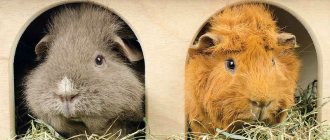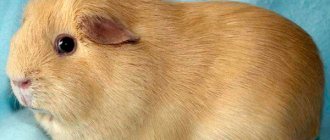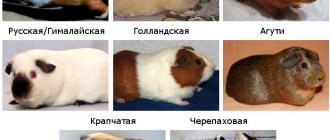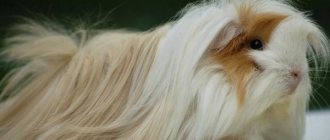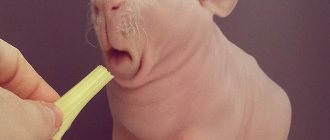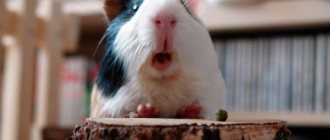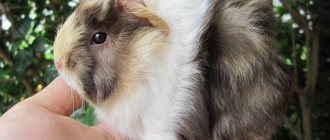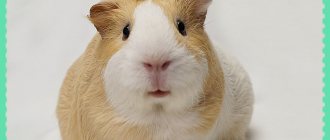18 March46043pet rodentsguinea pig
The guinea pig is a species of domesticated rodent. Despite their name, they are not related to marine animals and are not related to the pig family. The guinea pig has other names, it is called Guinea pig, as well as cavy or kewi. Guinea pigs are trusting and good-natured animals. In this article you will learn a lot of new and interesting things about the guinea pig.
Origin story
These animals were made tame back in the 5th millennium BC by representatives of the tribes of South America. The ancestors of modern inhabitants of the south of Colombia, Peru, Ecuador and Bolivia at one time consumed these mammals as food. According to scientists, wild guinea pigs wanted to be close to humans without any coercion. The Incas used guinea pigs as sacrificial animals, so they were constantly sacrificed to the sun god. Animals that had a variegated brown or pure white color were very popular. It is generally accepted that modern guinea pigs descended from their ancestors "Cavia aperea tschudi", which can be found in mountainous areas.
Interesting to know! Such mammals form small groups and live in very spacious underground burrows. Animals living in the mountains of Chile have significant differences in appearance when compared with domestic guinea pigs. This is due to their food supply, which is poor in water but rich in cellulose compounds.
Pedigree characteristics of life expectancy
There are no pronounced breed characteristics of life expectancy, but there are a couple of exceptions:
- There is a breed whose name is “Tortoiseshell with White”. If a potential breeder is initially determined to get a “long-lasting” pet, he should buy just such a pig. Representatives often live to be 10 years or more. The standard lifespan is 7 or 8 years.
- Crossbred varieties of the same tortoiseshell breed with a tricolor color, which are experienced, also have an impressive life expectancy.
Description of the guinea pig
Zoologists note that according to taxonomy, guinea pigs should be classified as part of the family of semi-ungulate rodents, while they have a characteristic appearance and a special structure.
Appearance
It is believed that the body structure of guinea pigs is similar in basic anatomical data to most domestic animals. There are some differences noted:
- Guinea pigs have a cylindrical body. The body length does not exceed 22 centimeters, although individuals of greater length are found.
- The animal's spine consists of seven cervical, twelve thoracic, six lumbar, four sacral and seven caudal vertebrae.
- The guinea pig lacks a tail and does not have collarbones as such.
- Males, compared to females, weigh slightly more, with adults weighing from 0.7 to 1.8 kilograms.
- Guinea pigs have fairly short legs, with the front legs being much shorter than the back legs.
- The front paws have 4 toes, and the hind paws have 3. The appearance of the toes more closely resembles small hooves.
- In one week, the size of the animals’ fur increases by almost half a centimeter.
- In the sacral area of pigs there are sebaceous glands, and within the genitals and anus there are paranal glands that secrete a special secretion.
- The guinea pig's head is relatively large, with a well-developed brain.
- An animal's incisors grow throughout its life, at a rate of up to 1.5 millimeters per week.
- The lower jaw of guinea pigs is capable of moving in any direction.
- The intestines are long enough and exceed the size of the animal’s body, so food can be digested for a whole week.
Animals can have different colors, structure and length of hair, which is associated with the main natural features, therefore, there are individuals with fairly short, very long, straight or wavy hair.
Behavior and lifestyle
Being in natural conditions, wild guinea pigs prefer to be active both at sunrise and at dusk. Despite their size, the animals run quite quickly and are considered very agile, always on the alert.
The wild guinea pig lives both in forests and in mountainous areas. To arrange their nest, they look for quiet, secluded places, but they do not dig holes. To form their home, they use dry grass, fluff and thin branches of trees and shrubs.
Interesting moment! Decorative guinea pigs are used not only as cute creatures that decorate a person’s home, but are also kept at various research institutions as experimental animals.
Wild animals are quite social, so they live in the same territory with many of their relatives. Each flock has several males, at the rate of one male for a couple of dozen females. The animals are quite active, so keeping them at home requires sufficient walking space. Pets rest (sleep) more than once a day, often with their eyes open.
How long does a guinea pig live?
Being in the natural environment, wild guinea pigs can live no more than 7 years, and at home, if all rules and regulations are followed, 2 times longer.
Guinea pig - All about the rodent species | Type of rodent - Guinea pig
How cats die - 5 signs of imminent death
Unfortunately, nothing in the world lasts forever and death accompanies us throughout our lives. Of course, the loss of a loved one cannot be compared with the departure of another cat into the world. But sometimes you become so attached to your beloved pet that you consider it a member of the family.
Owners rarely have to watch cats die. And all because most of them prefer to face death far from home, completely alone. But this does not always happen, since not everyone has the opportunity to go outside. To understand that the cat is dying and the time has come to let him go on his last journey, specific symptoms of his approaching death will help. After all, it is important to provide proper care for him during this difficult period.
What to do after the death of your pet?
Now it’s time to take care of the body, which is best wrapped in cloth and placed in a plastic bag. You must choose between cremation and burial. You can find out where the crematorium or special cemetery is located from your veterinarian. If the law does not prohibit burying a pet in a private area or outside the city, then you need to choose a suitable place. A picturesque corner on the shore of a pond under a tree is perfect. Animals cannot be buried in parks and squares.
READ How much should a guinea pig weigh?
Difficulty breathing is a sign of the approaching end
Other symptoms of a cat dying are changes in breathing. The heart can no longer work fully, so the amount of oxygen entering the lungs and blood decreases. The pet draws in air heavily and rapidly, trying to make up for the losses. In a healthy animal, the frequency of breaths per minute is 20–30. Shortness of breath, weak or infrequent breathing are symptoms of imminent death. It is not difficult to determine the indicator; just use a stopwatch and count the number of chest rises per minute.
Guinea pig breeds with photos
Guinea pigs are quite popular pets, so recently many new breeds have been artificially bred. The most popular include:
Alpaca
The breed is characterized by the presence of thick, beautiful, curly and long hair. These pigs have two rosettes located on the back, and one, which has an irregular shape, within the forehead. In the area of the muzzle, the hairs grow so that they form a kind of sideburns. On the legs, hair grows from bottom to top.
Texel
The breed is characterized by the presence of beautiful curly hair, which in appearance is similar to a wet perm. Due to its unique and attractive coat, the breed is very popular both here and abroad.
Abyssinian
It is considered one of the oldest and most beautiful breeds. This breed has a hard coat, and also has several rosettes consisting of fairly long hairs. Such pets have an excellent appetite, and the animals themselves are characterized as very active.
Merino
The breed is characterized by a number of characteristics, including large eyes and ears, as well as a short head and a strong, compact body. The breed has long and curly hair, developed cheeks and pronounced sideburns. A symmetrical and small “crown” can be seen on the animal’s head.
Peruvian
The breed has a long and very attractive coat that does not require any special grooming process. To prevent too long coats from becoming too dirty, guinea pig owners use special papilettes for this.
Rex
It is a variety of short-haired breeds with a coat of a special structure. As a result, the guinea pig resembles a small, living plush toy. The hair on the back and head is coarser than on the rest of the body.
Cornet
This breed has other names, such as “crested” or “wearing a crown”, which is associated with the presence of a peculiar crown between the ears of the animal, formed by a special rosette. The coat is long and evenly distributed throughout the body. The Cornet breed was born as a result of crossing the Sheltie and Crested breeds.
Sheltie
The breed has long and straight hairs with a silky shine. In the head area there is a kind of mane that falls over the shoulders and onto the back of the animal. Animals are born with short hair, and already in six months they have a full coat of hair.
Interesting to know! Baldwin guinea pigs have a very exotic and unusual appearance because they have no fur. On the animal's knees you can see several medium-length hairs.
The most popular breed among short-haired guinea pig breeds is the Self breed. This breed has a solid color, and the number of colors is amazing. With the slightest movements of the animal, many tones are reflected, which creates unique color tints.
PROS and CONS of keeping GUINEA PIGS / SvinkiShow
Table of the age of a rodent by human standards
The rodent's body develops very quickly; 1 year of life for a guinea pig is equivalent to 10-15 years for a human. In the table we can see the relationship between the age of a pet and the age of a person.
| Pig age | 2 weeks | 6 months | 2 years | 5 years | 7 years |
| Person's age | 6 months | 6.5 years | 26 years | 65 years old | 91 years old |
These are approximate indicators; individual parameters should always be taken into account.
Keeping at home
After acquiring an animal, its behavior can be quite sluggish and ambiguous, as the animal gradually gets used to the new living conditions. During this period, the guinea pig has a poor appetite, it is frightened by various movements and sounds, so it can sit motionless in one place for a long time. The adaptation process can and should be accelerated by creating a certain atmosphere in the home, characterized by calm and attention.
Cage, filling
In fact, guinea pigs are considered to be quite timid by nature, so they react negatively to changes in their living conditions. Animals can be kept either in a terrarium or in a cage with a tray, with the second option being more preferable. In the cage, it is necessary to provide something like a resting house (for sleeping), as well as place various game elements, a feeder and a drinking bowl. Naturally, the size of the house should take into account the size of the animal itself.
Care, hygiene
Guinea pigs do not tolerate both cold and excessive heat in the form of direct sunlight, so it is necessary to protect your pet from these negative factors. Water treatments are provided to the guinea pig as needed. Once a week you should brush your coat. Since the claws are unlikely to wear down naturally, they should be trimmed once a week.
If an animal participates in exhibition shows, then such a pet requires special attention. From an early age, they should be taught to sit still in one of the postures, and they should also be taught to patiently endure the daily processes of brushing. In this case, the animal must withstand the process of using the pills. Wire-haired and smooth-haired guinea pigs undergo periodic trimming.
What to feed
In the natural environment, guinea pigs eat components of plant origin, which include roots and seeds of plants, leaves, and fruits that have fallen from trees or shrubs. The basis of the diet of a domestic guinea pig is high-quality hay, which normalizes the functioning of the digestive system and also allows the rodent to grind its teeth. Due to the peculiarities of the digestive system, hay should be given to your pet quite often, but in small portions.
Good to know! Experts recommend feeding guinea pigs with ready-made food, at a rate of no more than one tablespoon per day.
Naturally, no one would recommend feeding a guinea pig exclusively with hay, so its diet should include succulent food in the form of berries, fruits and vegetables. As a treat, you can offer the animal sweet fruits, berries and the fruits of other cultivated plants. In order for the animal's teeth to constantly wear down, the animal must receive twigs of a cherry or apple tree, dandelion or celery root. The guinea pig's cage must contain fresh, clean water, and it must be changed every day.
Guinea pigs are exclusively herbivores, so any food items of animal origin should be excluded from the diet. In addition, it is not recommended to feed the pig milk, which can lead to upset of the animal’s digestive tract, since its body does not digest lactose well. The use of low-quality feed, as well as frequent and, especially, drastic changes in diet contribute to the development of various ailments, and often cause death.
Health, diseases and their prevention
The most common diseases that guinea pig owners may encounter are:
- Worms and external parasites.
- Alopecia or hair loss, which is the result of improper feeding of the animal, stress, lack of vitamins and minerals, as well as the appearance of parasites.
- Injuries and even fractures of limbs, which is associated with violation of maintenance rules.
- Rickets as a consequence of a lack of vitamin D.
- Colds (ARI), pneumonia, otitis media and cystitis, as a result of hypothermia or drafts.
- Anomalies of dental incisors.
- Disturbances in the digestive system. As a result, the animal develops diarrhea, constipation, flatulence or enteritis.
- Keratitis and conjunctivitis, as a result of exposure to infections, chemical and mechanical factors.
Improper nutrition (imbalance of nutritional components) leads to excess weight in your pet, which does not lead to anything good.
Reproduction and offspring
At the age of six months, you can already start mating guinea pigs. This process is possible within 2 weeks, while fertilization is possible within 8 hours. After pregnancy, the female carries her future offspring for about 2 months.
From 2 to 5 cubs are born, which are well developed and move independently. For a couple of months, the female feeds her cubs, but not longer.
Major deadly diseases
Most diseases that lead to the death of an animal are caused by improper feeding or feeding, as well as inattention to the animal. Some owners, when they detect alarming symptoms, turn to the Internet and forums, and go to the doctor too late.
Only in a veterinary clinic is it possible to make a correct diagnosis, and a veterinarian should prescribe treatment based on test results.
Some diseases occur very quickly and only a few days pass from the first symptoms to death. Therefore, it is necessary to know and understand the symptoms of dangerous diseases and be able to provide first aid.
Where and how to buy a guinea pig
As a rule, show and breeding class animals are the most expensive, since they are the ones who participate in exhibition shows and are the basis of any nursery or breeder. Pet-class pets are inexpensive and accessible to citizens of any category.
The cost of animals includes various factors, such as gender, quality, color, and origin. Imported animals cost at least 15 thousand rubles, since transportation is not cheap at all. Regardless of origin, the pig must be absolutely healthy, well-fed and very active. The eyes and nose should be clean, and the coat should be well-groomed, without scratches or bald spots.
Reproduction
Wild cavias are very prolific. It is this quality that allows a population to exist. The female gives birth to her first litter at the age of 6-7 months. Most often, females give birth up to four times a year, and the number of cubs in each brood is from seven to ten. Babies are born fully formed and ready for life. Their eyes are open, they have all their teeth, and their fur is dense and warm. They spend the first five to six days near their mother. Seven-day-old babies can already eat grass and young roots, but still depend on mother's milk. Two-week-old pigs independently explore the territory and feed, only occasionally returning to the nest.
Owner reviews
Naturally, high-end guinea pigs are inaccessible to ordinary buyers. In any case, if you plan to breed them, you should opt for purebred specimens.
Interesting to know! In our country, guinea pig breeding has not yet reached such a high level as abroad. Despite this, true connoisseurs of these animals try to acquire individuals that have an attractive and exotic appearance.
It should also be remembered that you cannot cross long-haired and short-haired representatives of the breeds, since the result will be offspring that are low-quality mestizos and no one will allow them to be shown at exhibitions. On top of that, crossing different breeds is also unacceptable because it hinders the improvement of the breed data of any of the species.
Guinea pigs have earned the right to be considered one of the most sought-after pets. Ease of care and maintenance is acceptable for everyone, even novice owners. This is an affectionate and sociable animal that is perfect for families with children.
Nail care
Claw care is extremely important. If the claws are not trimmed, they grow so long that the paws become deformed. The procedure is carried out twice a year for animals that have reached one year of age. For the procedure you need:
- nail clippers;
- towel;
- hemostatic powder.
The pig is taken out of the cage and placed on a towel spread on his lap. Then you need to wait a little for the animal to come to its senses and calm down. When the pet relaxes and feels safe on its owner’s lap, you can begin to slowly and calmly cut off the claws from its paws. If a blood vessel is accidentally damaged during the procedure, a hemostatic powder is applied to the wound.
